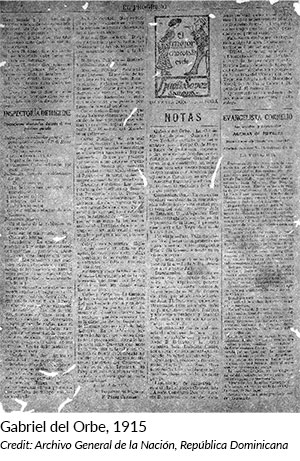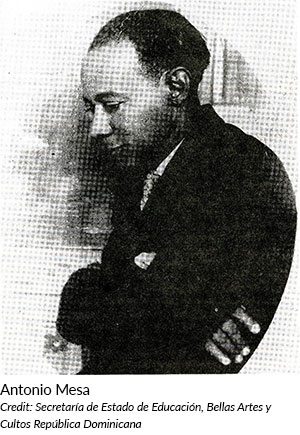Narrative: 1910s & 1920s: The Early Presence of Dominican Music
In the early 20th century, the advent of recorded music and radio broadcasting reshaped the musical landscape of New York City. As the Dominican Republic experienced a lengthy U.S. military occupation, from 1916 to 1924, Dominican musicians began arriving in the U.S., particularly to New York City. The majority of Dominican musicians traveling were primarily trained in municipal or military bands and performed classical music, boleros, or styles that were still crystalizing, such as merengue. In New York City, Dominican musicians found a context of significant cross-cultural exchanges and musical hybridization, as they played alongside Puerto Ricans, Cubans, and African-Americans. This racial and cultural diversity not only set the stage for Dominicans' direct participation in major music movements in the United States, it also meant that Dominican artists ended up contributing to genres that would come to be known as staples of Latin music in the U.S.
"...the first known Dominican to ever record his music was Gabriel del Orbe..."
 Current evidence suggests that the first known Dominican to ever record his music was Gabriel del Orbe, a skilled violinist who arrived to the U.S. in 1907, later moving to Leipzig, Germany to study under musician Arno Hief. In 1914, del Orbe returned to New York City from his studies in Germany for a series of performances at the Waldorf-Astoria Hotel and Carnegie Music Chamber Hall. Among the numbers he performed were two of his own compositions, “Melodía” and “Rhapsody” as well as Handel’s Sonata in E. Lalo’s “Symphonie Espagnole.” On June 19, 1915, his recordings for what is now Columbia Records were first mentioned in print, in the Dominican newspaper El Progreso La Vega.
Current evidence suggests that the first known Dominican to ever record his music was Gabriel del Orbe, a skilled violinist who arrived to the U.S. in 1907, later moving to Leipzig, Germany to study under musician Arno Hief. In 1914, del Orbe returned to New York City from his studies in Germany for a series of performances at the Waldorf-Astoria Hotel and Carnegie Music Chamber Hall. Among the numbers he performed were two of his own compositions, “Melodía” and “Rhapsody” as well as Handel’s Sonata in E. Lalo’s “Symphonie Espagnole.” On June 19, 1915, his recordings for what is now Columbia Records were first mentioned in print, in the Dominican newspaper El Progreso La Vega.
The vibrant and booming music industry in New York City provided a fertile opportunity for Dominican artists residing there to export their work to Latin America. Notable early compositions include Rafael Petitón Guzmán's "Amor Sediento," a waltz recorded with Paco Tizol in Camden, NJ in 1921.[1] One year later, Juan Bautista Espínola became the first Dominican composer to have a merengue instrumental recorded in the U.S. "Rubén" was recorded in 1922 by the RCA Victor house band known as the International Novelty Orchestra.
The U. S., and particularly New York City, would become instrumental places conducive for Dominicans who wanted to record music. Deborah Pacini Hernandez notes that from the 1920s to the 1940s most Dominican music was recorded in the U.S. since the Dominican Republic lacked the appropriate infrastructure required to nurture a competitive music recording industry.[2]
"Perhaps the most influential Dominican musician of the early era of New York Latin music was Antonio Mesa, a Santo Domingo-born vocalist who is widely considered the first star of Dominican popular music..."
 Perhaps the most influential Dominican musician of the early era of New York Latin music was Antonio Mesa, a Santo Domingo-born vocalist who is widely considered the first star of Dominican popular music. Mesa was the first Dominican singer to record his voice. He made his professional debut in the Dominican Republic in 1915, moving to New York City in 1921. In 1926, Mesa replaced Manuel "Canario" Jiménez of the pioneering Puerto Rican Trío Borinquen, joining the group alongside the famous Puerto Rican bandleader Rafael Hernández and second vocalist/guitarist Salvador Ithier. Prior to Mesa joining Trío Borinquen, the group already had distinguished itself by recording with Columbia Records. Trío Borinquen (click here to listen) continued to record with Columbia Records now incorporating music from Dominican composers alongside the group's repertoire of Puerto Rican compositions. By providing a platform to some Dominican composers, Trío Borinquen was in fact opening a door for Dominican composers who had been struggling to secure contracts with record labels in the U.S.
Perhaps the most influential Dominican musician of the early era of New York Latin music was Antonio Mesa, a Santo Domingo-born vocalist who is widely considered the first star of Dominican popular music. Mesa was the first Dominican singer to record his voice. He made his professional debut in the Dominican Republic in 1915, moving to New York City in 1921. In 1926, Mesa replaced Manuel "Canario" Jiménez of the pioneering Puerto Rican Trío Borinquen, joining the group alongside the famous Puerto Rican bandleader Rafael Hernández and second vocalist/guitarist Salvador Ithier. Prior to Mesa joining Trío Borinquen, the group already had distinguished itself by recording with Columbia Records. Trío Borinquen (click here to listen) continued to record with Columbia Records now incorporating music from Dominican composers alongside the group's repertoire of Puerto Rican compositions. By providing a platform to some Dominican composers, Trío Borinquen was in fact opening a door for Dominican composers who had been struggling to secure contracts with record labels in the U.S.
"...Trío Borinquen was in fact opening a door for Dominican composers who had been struggling to secure contracts with record labels in the U.S."
 Between 1927 and 1931, Rafael Hernández wrote 54 songs alongside several Dominican composers, including Bienvenido Troncoso, Julio Alberto Hernández, and Esteban Peña Morell, among others. Compositions popularized by Antonio Mesa, such as "Linda Quisqueya (click here to listen)," exemplify the influence of these composers. When compositions referenced Dominican themes, Trio Borinquen would record under the name of Trio Quisqueya, which indicated an intimate connection to the Dominican national and ethnic identity and helped to expand the group’s fan base in the Dominican Republic.
Between 1927 and 1931, Rafael Hernández wrote 54 songs alongside several Dominican composers, including Bienvenido Troncoso, Julio Alberto Hernández, and Esteban Peña Morell, among others. Compositions popularized by Antonio Mesa, such as "Linda Quisqueya (click here to listen)," exemplify the influence of these composers. When compositions referenced Dominican themes, Trio Borinquen would record under the name of Trio Quisqueya, which indicated an intimate connection to the Dominican national and ethnic identity and helped to expand the group’s fan base in the Dominican Republic.
Like other excluded groups during this time, Borinquen mostly played in segregated clubs located in Manhattan, a hub for African Americans, Cubans, Puerto Ricans, and Caribbean peoples. Trío Borinquen, however, managed to play at Hurtig & Seamon's New Burlesque Theater in 1928, a venue reserved exclusively for whites at the time. Hurtig & Seamon's New Burlesque Theater would later become the Apollo Theater. By 1929, when the group played at the Harlem Opera House, a venue that originally catered exclusively to whites, Trío Borinquen had already gained international recognition, had signed with a prestigious record label, and boasted among its members musicians of the caliber of Rafael Hernandez, who had a track-record performing with polished, well-known African American and Cuban groups.
Although Dominican, Puerto Rican, and Cuban artists sometimes played alongside African-Americans in spaces like the Cotton Club and Small's Paradise, for the most part, early New York Latin music remained relegated to Spanish-speaking venues until the 1930s. The rhumba, mambo, and cha cha crazes of the 1930s, 1940s, and 1950s created more opportunities for Dominican, Puerto Rican, and Cuban artists to perform in venues located outside of Spanish speaking neighborhoods.
Trío Quisqueya disbanded in 1932, but Grupo Dominicano (click here to listen) emerged as another influential Dominican band active in New York in the early 20th century. Julio Alberto Hernández, a Dominican composer who had secured a contract with Columbia Records as a result of Trío Borinquen's success, formed the group in the Dominican Republic in 1929. Hernández offered Dominican vocalist Eduardo Brito and his wife Rosa Elena Bobadilla the opportunity to travel and perform in New York City. Composed of Eduardo Brito, Bienvenido Troncoso, Luis María “Chita” Jiménez and Enrique García, Grupo Dominicano (click here to listen to recording 1, 2, and 3) recorded 50 tracks for RCA Victor in December of 1929. Though the rest of the musicians returned to Santo Domingo, Brito and Bobadilla remained in the U.S., and would go on to establish solid careers by performing live throughout Manhattan, as the country's first Latin dance craze unfolded in the early 1930s.
[1] Cousin of Juan Tizol, Puerto Rican trombonist in Duke Ellington's orchestra.
[2] Pacini Hernandez, Deborah. Bachata: A Social History of a Dominican Popular Music. Philadelphia: Temple University Press, 1995.